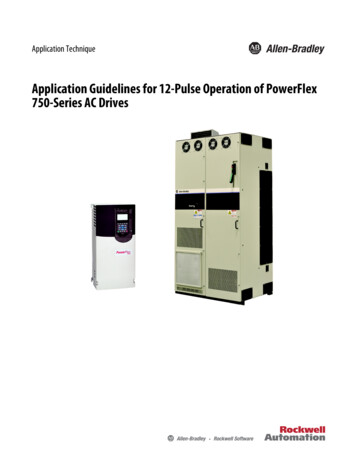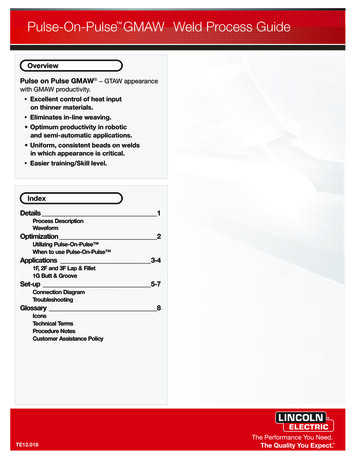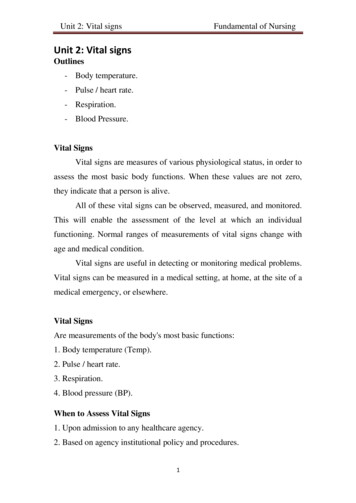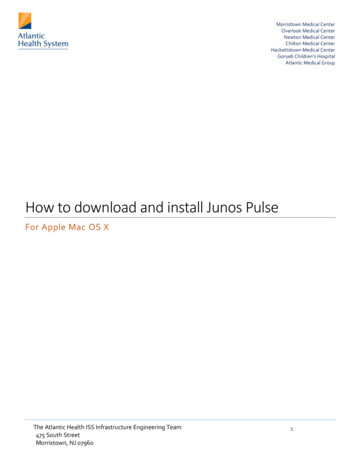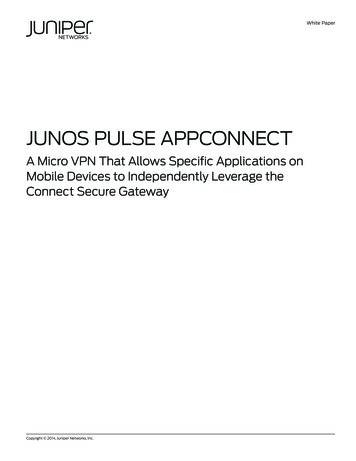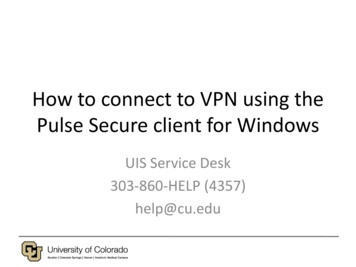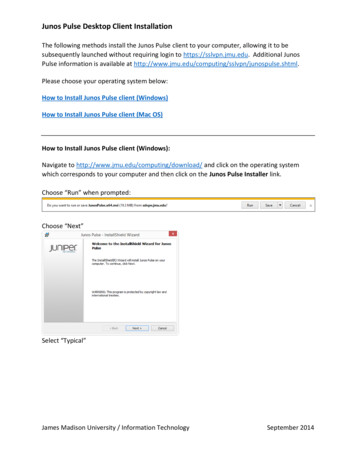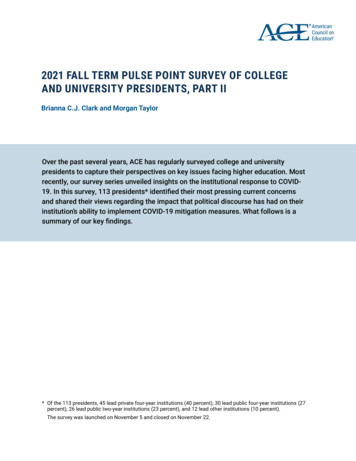
Transcription
AmericanCouncil onEducation2021 FALL TERM PULSE POINT SURVEY OF COLLEGEAND UNIVERSITY PRESIDENTS, PART IIBrianna C.J. Clark and Morgan TaylorOver the past several years, ACE has regularly surveyed college and universitypresidents to capture their perspectives on key issues facing higher education. Mostrecently, our survey series unveiled insights on the institutional response to COVID19. In this survey, 113 presidents* identified their most pressing current concernsand shared their views regarding the impact that political discourse has had on theirinstitution’s ability to implement COVID-19 mitigation measures. What follows is asummary of our key findings.* Of the 113 presidents, 45 lead private four-year institutions (40 percent), 30 lead public four-year institutions (27percent), 26 lead public two-year institutions (23 percent), and 12 lead other institutions (10 percent).The survey was launched on November 5 and closed on November 22.
MOST PRESSING ISSUES FOR PRESIDENTSIn the November 2021 survey, presidents were presented with a list of 19 issues and asked to select up to five that theyviewed as most pressing (see Figure 1). For the seventh time since April 2020, “mental health of students” was the pressing issue cited most frequently by presidents. Nearly three-quarters of all presidents (73 percent) in the November surveyidentified student mental health as a pressing concern, the same percentage that chose it in the September 2021 survey. Slightly less than two-thirds of presidents (63 percent) identified “enrollment numbers for the next academicterm” as a pressing issue, a slight increase from 59 percent of presidents who reported this in the September 2021survey. Over half of all presidents (57 percent) selected “mental health of faculty and staff” as a pressing concern, a 3percentage point increase from the total share of presidents who reported this as a pressing issue in the Septembersurvey (54 percent). For the second consecutive survey, the fourth most frequently selected pressing issue was “long-term financialviability,” with 43 percent of presidents reporting this as a top-of-mind issue. “Retention of faculty and/or staff” was the fifth most frequently chosen pressing concern among college and university presidents, with 35 percent of presidents selecting this issue. “Racial equity issues” was selected by one-third (33 percent) of all presidents as a pressing issue, a 4 percentagepoint increase from the September 2021 survey (29 percent).Figure 1: Most Pressing Issues Facing Presidents in September and November 2021Figure 1: Most Pressing Issues Facing Presidents in September and November 2021NOVEMBERSEPTEMBERMental health: students73%73%Enrollment numbers for nextterm63%59%Mental health: faculty and staff57%54%Long-term nancial viability43%42%Retaining current faculty and/orstaff35%29%Racial equity issues33%29%Recruiting new faculty and/orstaff26%23%Short-term nancial viability19%20%Impact of COVID-19 restrictionson campus17%20%International student enrollment16%17%Managing senior-level team14%7%Fundraising12%16%Spring academic term operatingplans*12%0Food- and housing-insecurestudents10%15%Emergency aid9%12%Respond to governing boardconcerns7%8%Other6%5%Impact of natural disasters oncampus community4%4%Intercollegiate athleticsSupport for students andrefugees from AfghanistanFall semester operating plans**2%3%0.0%0.4%04%*Denotes item available in the November survey only.**Denotes item available in the September survey only.Pulse Point Survey of College and University Presidents on COVID-19: November Survey, American Council on Education, 2021.2
POLITICIZATION OF COVID-19 VACCINES AND OTHER MITIGATION EFFORTSTensions and protests in response to some COVID-19 public health measures have cropped up in a number of placesacross the country, especially around the mitigation measures that businesses and governments can require, includingmandatory vaccination and mask-wearing. Higher education institutions were not immune to these tensions as theybrought their students, faculty, and staff back on campus for the fall term, though these pressures were not felt evenlyacross all sectors of institutions and all parts of the country. Importantly, most presidents who responded to this surveynoted that the vast majority of campus stakeholders have been supportive of COVID-19 mitigation measures.Presidents were asked to identify their level of agreement that political discourse about the pandemic negatively affectedtheir institution’s ability to implement COVID-19 mitigation measures (e.g., vaccine mandates, mask mandates, testing)(see Figure 2). Presidents at public four-year institutions (74 percent) were the most likely to indicate that they agreedthat political discourse affected their institution’s ability to implement these measures, followed by presidents at publictwo-year institutions (65 percent). Presidents at private four-year institutions (58 percent) were least likely to agree thiswas a problem.Figure2. ReportedLevelLevelof AgreementThat PoliticalDiscourseAbout theAboutPandemicFigure2. Reportedof AgreementThat PoliticalDiscoursethe NegativelyPandemicAffectedAbilityAffectedto tyto ImplementCOVID-19Mitigation MeasuresAll institutions 21%42%Public four-year 27%Private four-year 16%24%47%13%42%Public two-year 23%31%42%Strongly agreeDisagreeStrongly disagree3%10%3%9%27%Agree10%8%UnsurePulse Point Survey of College and University Presidents on COVID-19: November Survey, American Council on Education, 2021.Presidents were also asked to report their level of agreement with this statement: “Federal government requirementsrelated to COVID-19 vaccines for faculty and staff had created tension with my state government.” (see Figure 3). Overall, 21 percent of presidents strongly agreed and 27 percent of presidents agreed that federal government requirementsrelated to COVID-19 vaccines for personnel have created tension with their state governments.Figure3. ReportedLevelLevelof AgreementThat FederalGovernmentRequirementsRelated to COVID-19Figure3. Reportedof AgreementThat ultyandStaffCreatedTensionwithStateGovernmentto COVID-19 Vaccines for Faculty and Staff Created Tension with State GovernmentAll institutions 21%27%Public four-year 23%27%Private four-year 22%Public two-year 15%26%23%31%AgreeDisagreePulse Point Survey of College and University Presidents on COVID-19: November Survey, American Council on Education, 2021.33%22%35%Note: Due to rounding, numbers may not equal 100 percent.4%23%22%31%Strongly agree21%12%Strongly disagreeUnsure8%
As institutions across the nation continue to navigate the implications of COVID-19, presidents were provided witha list of six stakeholder groups and asked to indicate the level of support their institution received from each groupsurrounding the implementation of COVID-19 prevention measures on their campus (see Figure 4). Across the board,presidents reported that they received support from all stakeholder groups in the implementation of COVID-19 prevention measures. Nearly three-quarters of all presidents (73 percent) reported that their governing board had been very supportivein the institution’s implementation of COVID-19 prevention measures. Just under half of all presidents (46 percent) reported that their faculty and staff had been very supportive. Overall, 88 percent of presidents reported that their students were very supportive or supportive in the institution’s implementation of prevention measures. By sector, presidents at public four-year (94 percent) and privatefour-year (93 percent) institutions were more likely than presidents at public two-year institutions (81 percent) toreport support from students. Presidents at private four-year institutions (84 percent) were the most likely to report some level of support fromtheir local community as it related to their institution’s efforts to implement COVID-19 prevention measures, thehighest share of any sector. Nearly one-quarter (23 percent) of presidents at public four-year institutions reportedthat their local communities were “unsupportive,” the highest share across all sectors.Figure 4. Reported Level of Support Institution Received from Stakeholder Groups RelatedFigure 4. Reported Level of Support Institution Received from Stakeholder Groups Related toto Implementation of COVID-19 Mitigation Measures on CampusImplementation of COVID-19 Prevention Measures on CampusPUBLIC FOUR-YEARALL INSTITUTIONSLocal community 38%45%State government37%o cials39%Alumni 20%37%67%17%PRIVATE FOUR-YEAR42%State government38%o cials36%Institution's governing80%boardStudents 29%Alumni 27%PUBLIC TWO-YEAR11%Local community 28%11% 11%State government32%o cialsStudents 19%64%Very supportive16%31%Unsupportive8%62%12%62%8%Alumni 12% 32%7% 13%Supportive12% 8%48%Faculty and staff 27%42%51%52%Institution's governing62%board18%Faculty and staff 56%7%Alumni 10% 67%24%10%55%Students 27%60%Local community 42%17%30%Faculty and staff 45%50%48%23%Institution's governing67%board24%Faculty and staff 46%37%State government37%o cials13% 9%Institution's governing73%boardStudents 28%Local community 40%13%Very unsupportive8%48%UnsureWe sought to better understand how presidents are navigating the politicization of COVID-19 prevention measures ontheir campuses. Presidents across the board expressed that they primarily avoid politicizing COVID-19 in their institutional decision-making processes and based their decisions on Centers for Disease Control and Prevention (CDC), state,and federal guidelines backed by science. Presidents also shared that approaching conversations surrounding mandatesand COVID-19 mitigation measures with stakeholders requires a delicate balance of consideration of stakeholder viewsand guidelines with communication that is clear and consistent. One president stated, “We never make anyone happy(we’re always doing too much or too little), but I think we’re consistent—we follow CDC and state guidelines (andthankfully those are in agreement).”Pulse Point Survey of College and University Presidents on COVID-19: September Survey, American Council on Education, 2021.4
Collectively, presidents reported that although there have been “vocal critics,” those voices are minimal. The vast majorityof campus stakeholders continue to support university efforts surrounding the implementation of COVID-19 mitigationmeasures on campus, such as required vaccination and indoor mask mandates. One president shared, “Our focus wasnot on what divides us in this space, but how we live up to our notion that we are a community of learners committed todoing all the good we can for and with each other.”The brief was prepared by Brianna C.J. Clark and Morgan Taylor, under the direction of Hironao Okahana. Clarkcontributed to data cleaning and analysis, as well as development of the written brief. Taylor contributed to thedesign and distribution of the instrument, development of the written brief, and data cleaning; prepared the figures;and supervised the project.The authors would like to acknowledge the following individuals for their support in the production and review ofthis publication: Derrick Anderson, Hollie M. Chessman, Benjamin G. Cecil, Ty C. McNamee, Ashley Gray, MushtaqGunja, Robin Matross Helms, Liz Howard, Sherri Hughes, Anne Meehan, Jon Riskind, and Maria Claudia Soler, fortheir thoughtful insights and review of the survey instrument and written publication, and Lindsay Macdonald andAlly Hammond, for editorial support and making the data come to life through design.5
F ig ur e3. Rp o tdL v lfA mnTh aG q s to COVID-19 Vaccines for Faculty and Staff Created Tension with State Government Note: Due to rounding, numbers may not equal 100 percent. Pulse Point Survey of College and University Presidents on COVID-19: November Survey, American Council on Education, 2021.

